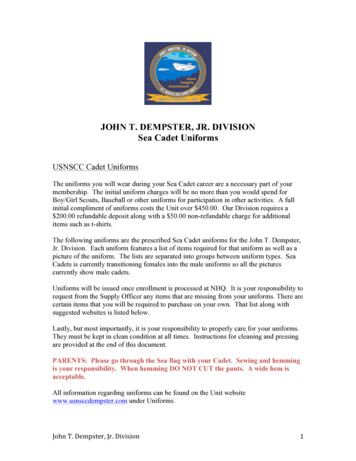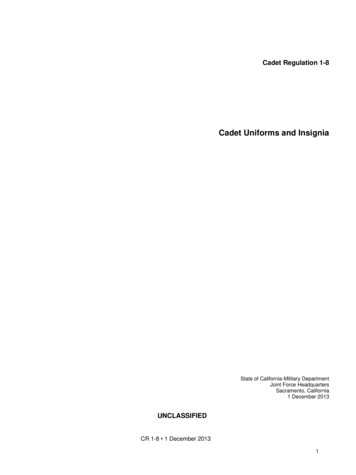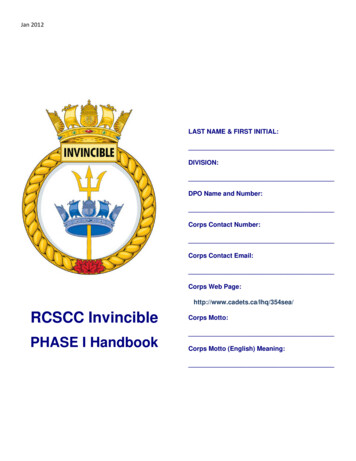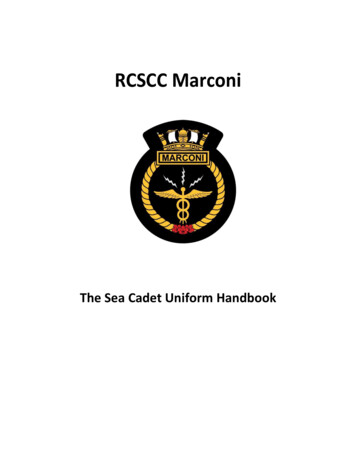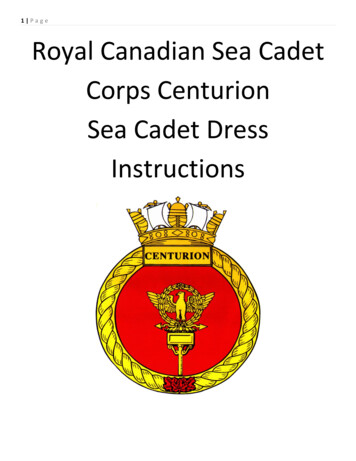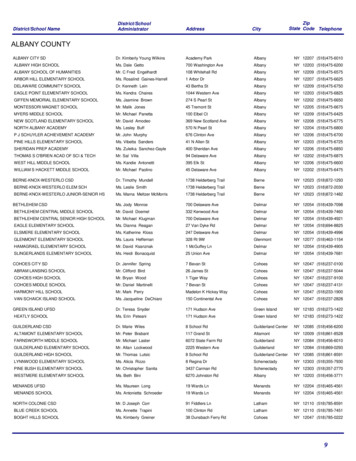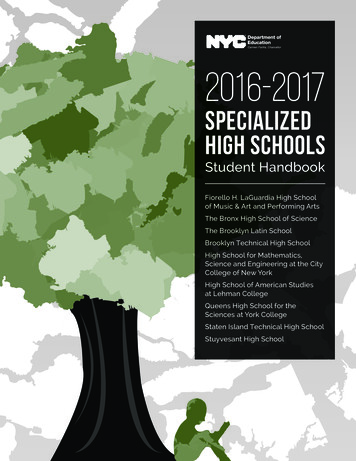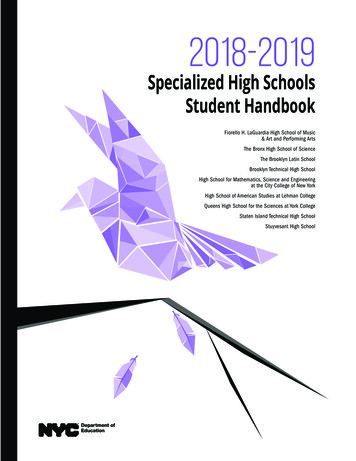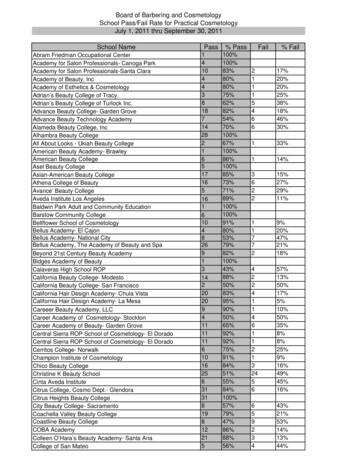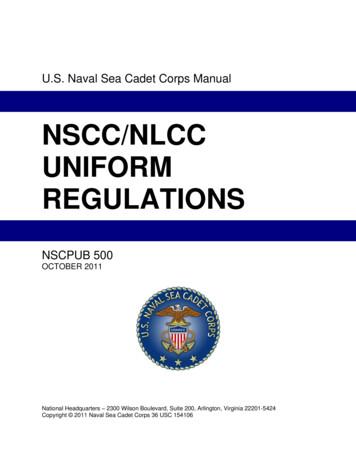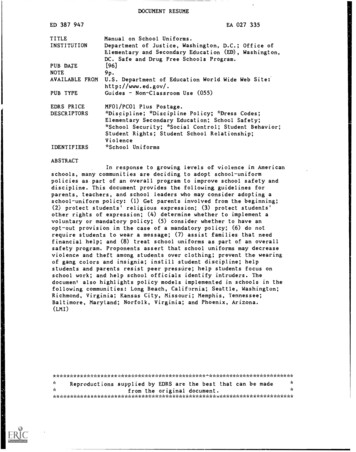
Transcription
r - - - - - - - - - - - - - - - - - - - - - -- - - - - · -·-- - - · -··----DOCUMENT RESUMEED 387 947TITLEINSTITUTIONPUB DA ENOTEAVAILABLE FROMPUB TYPEEDRS PRICEDESCRIPTORSIDENTIFIERSEA 027 335Manual on School Uniforms.Department of Justice, Washington, D.C.; Office of lementary and Secondary Education (ED), Washington,DC. Safe and Drug Free Schools Program.[96]9p.U.S. Department of Education World Wide Web Site:http://www.ed.govGuides - Non-Classroom Use (055)MFOl/PCOl Plus Postage.*Dis ipline; *Discipline Policy; *Dress Codes;Elementary Secondary Education; School Safety;*School Security; *Social Control; Student Behavior;Student Rights; Student School Relationship;Violence*School UniformsABSTRACTIn response to growing levels of violence in Americanschools, many communities are deciding to adopt school-uniformpolicies as part of an overall program to improve school safety anddiscipline. This document provides the following guidelines forparents, teachers, and school leaders who may consider adopting aschool-uniform policy: (1) Get parents involved from the beginning;(2) protect students' religious expression; (3) protect students'other rights of expression; (4) determine whether to implement avoluntary or mandatory policy; (5) consider whether to have anopt-out provision in the case of a mandatory policy; (6) do notrequire students to wear a message; (7) assist families that needfinancial help; and (8) treat school uniforms as part of an overallsafety program. Proponents assert that school uniforms may decreaseviolencP. and theft among students over clothing; prevent the wearingof gang colors and insignia; instill student discipline; helpstudents and par nts resist peer pressure; help students focus onschool work; and help school officials identify intruders. Thedocument also highlights policy models implemented in schools in thefollowing communities: Long Beach, California; Seattle, Washington;Richmond, Virginia; Kansas City, Missouri; Memphis, Tennessee;Baltimore, Maryland; Norfolk, Virginia; and Phoenix, ons suvplied by EDRS are the best that can be made,.,from the original *******H**********************0E C
1annat onc 00US DEPARTMENT OF EDUCATIONou.cp 1. ' ff1.1Cdi Qna R ed cl'\ tll'10 '"'P'OYei'T'e:llEDUCAToONAL RESOURCES INFORMATION. /CENTER (ERIC)Cl' Thts document has been reproduced as ccetved lrom the person or otgamzatoonongmat ngt!M nor0changes have been made totrnprovc rcproductton G Jahty ro.nts o! vtew or optnrons stated 1n ;htsdocument do not necessarily representolltc al OERI osthon or pohcv ('{')({')1:' C'(\0G:L.\lE&LCBEST COPY AVAILABLE2
------------------ -------------------Scbc:tOI Uniforms: Where They Are and Why They WorkAsafe and disciplined learning environment is the first requirement of a good school. Youngpeople who are safe and secure, who learn basic American values and the essentials of good citizen ship, are better students. In response to growing levels of " olence in our schools, many parents,teachers, and school officials have come to see schoo! uniforms as one positive and creative way toreduc:e discipline problems and increase school snfety.They ob rved that the adoption of school uniform policies can promote school safety, im prove discipline, and enhance the learning environment. The potential benefits of school uniformsinclude: decrtasing violence and theft- even lift·thrtatening situation.t -among students (JVerdesigner clothing or uptnsivt sneakers: helping prevent gang members from wearing gang color.t and insignia at .tc:hool: instilling students with discipline:' htlping parents and students resist peer pressure: helping students concentrate on their school worlc; and htlping school officials recognize intruders who come w the .tc:hool.As a result, many local communities are deciding to adopt school uniform policies as pan of anoverall program to improve school safety and discipline. California, Florida, Georgia, Indiana,Louisiana. Maryland, New York, Tennessee, Utah and Virginia have enacted school uniform regula tions. Many large public school systems -including Baltimore, Cincinnati, Dayton, Detroit, LosAngeles, Long Beach, Miami, Memphis, Milwaukee, Nashville. New Orleans, Phoenix, Seattleand St. Louis - have schools with either voluntary or mandatory uniform policies, mostly in el eanentary and middle schools. In addition, many private and parochial schools have required uni forms for a number of years. Still other schools have implen.\.:'lted dress codes to encourage a safeenvironment by, for example, prohibiting clothes with certain language or gang colors.Users' Guide to Adopting a School Uniform PolicyThe decision whether to adopt a uniform policy is made by states, local school districts, andschools. For uniforms to be a success, as with all other school initiatives, parents must be involved.The following information is provided to assist parents, teachers. and school leaders in determining.whether to adopt a school uniform policy.1.Get ptUena imol fromtit beginningParental support of a uniform policy is critical for success. Indeed, the strongest push forschool unifnnns in recent years has come from parent groups who want better discipline in theirchildren's schools. Parent groups have actively l bbied schools to create uniform policies and haveoften led school task forces that have drawn up uniform guidelines. Muny schools that have suc·cessfully created a uniform poHty survey parents first to gauge support for school uniform require ments and then seek parental input in designing the uniform. Parent support is also essential inencouraging students to wear the uniform.\lERLC"*"'* ,.3
------------ ------ ------------------- 2.Protect students' religious expnsslonA school uniform policy must accommodate students whose religious beliefs are substan tially burdened by a uniform requirement As U.S. Secretary of Education Richard W. Riley statedin Religious :xpraslon In Public Schools, a guide he sent to superintendents throughout thenation "n August 10, 1995:Students may display religious messages on items of clothing to the same extent that they ·are permitted to dtsplay other comparable messages. Religious messages may not be singledout for suppression, but rather are subject to the same rules generally apply to compa rable messages. When wearing particular attire, such as yarmulkes and head scarves, dur ing the school day is part of students' religious practice, under the Religious Freedom Res toration Act schools generally may not prohibit the wearing of such items.3.Prot ct students' othtr rightsG/ expressionA uniform policy may not prohibit students from wearing or displaying expressive items for example. a button that supports a political candidate - so long as such items do not ind pen dently contribute to disruption by substantially interfering with discipline or with the rights ofothers. Thus. for example, a uniform policy may prohibit students from wearing a button bearing agang insignia. A t.miform policy may also prohibit items that undermine the integrity of the uni form, notwithstanding their expressive nature, such as a sweatshirt that bears a political messagebut also covers or replaces the type of shirt required by the uniform policy.4.Determine whether to have a voluntary or mandatory school uniform r·,licySome schools have adopted wholly V\iluntary school uniform policies which permit stu dents freely to choose whether and under wha circumstances they will wear the school uniform.Altemativc:ly, some school5 have determined that it is both warranted and more effective to adopta mandatory uniform policy.5.When a mandmory school uniform policy is adopkd, d nnln whther to luJve an optout provisioaIn most cases. school districts with mandatory policies allow students, nonnatly with paren tal consent, t"' opt out of the school unifonn requirea ents.Some schools have determined. however. that a. :nandatory policy with no opt out provisionis necessary to address a disruptive atmosphere. A Phoenix, Arizona school. for example, adopteda mandatory policy requiring students to wear school unifcwms, or in the alternative attend anotherpublic school. That Phoenix school uniform policy was recently upheld by a state trial court inArizona. Note that in the absence of a finding that disruption of the learning environment hasreached a point that other, lesser meas9res have been or wovld be ineffective, a mandatory schooluniform policy without an opt out provision could be vulnenkh1e to legal challenge.6.Do not require students to wear a messageSchools should not impose a form of expression on student by requiring them to wearuniforms bearing a substantive message, such as a political message.a. li llll.lllllll2\)EB.LC4
----------------------- ---------------------7.Assist familUs tlud ne1dflnancUd la1lpin many cases, school unifonns are le s expensive than the clothing that students typicallywear to school. Nonetheless, the cost of purchasing a unifonn may be a burden on some families.School districts with uniform policies should make provisions for students whose families are un able to afford uniforms. Many have done so. Examples of the t pes of assistance include: (a) theschool district provides uniforms to students who cannot afford to purchase them (b) communityand business leaders provide uniforms or contribute financial support for uniforms (c) school par ents work together to make uniforms available for economically disadvantaged students and (d)used uniforms from graduates are made available to incoming students.8.l'nat sclwol uniforms as JHirl ofa11 overaU saj1ty progrtzmUniforms by t.hemselves cannot solve all of the problems of school discipline. but they canbe one positive contributing factor to discipline and safety. Other initiatives that many schools haveused in conjunc;tion with uniforms to address specific problems in their com111unity include aggres sive truancy reduction initiatives, drug prevention efforts, student-athlete drug testing, community ·efforts to limit gangs. a zero tolerance policy for weapons. character education classes, and conflictresolution programs. Working with parents, teachers, students, and principals can make a uniformpolicy part of a strong overall safety program, one that is broadly supported in the community.Model School Uniform PoliciesStates and local school districts must decide how they will ensure a safe and disciplinedlearning environment. Below are some examples of school districts that have adopted school uni forms as part of their strategy.Loaa Beach, CaliforniaTypt:Uniforms are mandatory in all elementary and middle schools. Each schoolin the district det-:rmiqes the uniform its students will wear.Opt-out:Yes, with parental consentSill ofprogram:SS,SOO elementary and middle school studentslmplem1ntation dati: 1994Support fCJr disadvantaged studenu: Each school must develop an assistance plan for families thatcannot afford to buy unifonns. In most cases, graduating students either donate or sell used uni forms to needy families.Results: District officials found that in the year following implementation of the school unif0f11lpolicy. overall school crime decreased 36 percent, fights decreased S I percent. sex offenses de creased 74 percent, weapons offenses dec.-eased SO percent, assault and battery offenses decreased34 percent, and vandalism decreased 18 percent. Fewer than one percent of the students haveelected to opt out of the uniform policy.·0EB.LCHffifli ··'11 --5---- --- -- - - - - - - - - - - - - - - -
Dick Van Ocr Laan of the Long Beach Unified School District explained, .We can't at tribute the improvement exclusively to school unifornl , but we think it's more than coincidental."Accordina to LonJ Beach police chief William Ellis, .Schools have fewer reasons to call the police.Therc s less confhct among students. Students concentnte more on education, not on who's wear- ·ina 100 shoes or gang attire."Seattle, WashingtonMandatory uniform policy at South Shore Middle SchoolOpt-out:Yes, with parental consent Students who opt out must attend another middleschool in the district. ·Size ofprogram:900 middle school studentslmplementalion date: 199S ·Support for dist:Jdvanwged students: South Shore works with local businesses that contribute fi nancial support to the uniform program. In addition, the administration at South Shore found thatthe average cost of clothing a child in a school with a prescribed wardrobe is less tban in schoolswithout such a program, sometimes 80 percent less. School officials believe that durability reus ability and year-to-year consistency also increase the economy of the school's plan.Results: The principal of South Shore, Dr. John Oennan, reports that "this year the demeanor in theschool has improved 98 percent, truancy an.J tardies are down, and we have not had one reportedincident of theft." Dr. Oennan explains that he began the uniform program because his studentswere .draggin', saggin' and laggin'. I needed tc keep them on an academic focus. My kids werereally into what others were wearina." Only five students have elected to attend another publicschool.Rkbmond, VirginiaType:Voluntary uniform policy at Maymont Elementary School for the Ans andHumanitiesOpt-out:Uniforms are voluntary.Siz.e ofprogram:262 elementary school students/n;ple Mntationd4te: 1994Support for diSIJdvantaged .students: Responding to parent concerns about the cost of uniforms,the school sought community financial support for the uniform program. Largely as a result offinancial donations from businesses and other community leaders, the percentage of students wear ing unifonns rose from 30 percent in 1994-9S, the first year of the program, to 8S percent during thecurrent year.Results: Maymont principal Sylvia Richardson identifies many benefits of the uniform program,including improved behavior, ah increase in attendance rates and higher student achievement.4G\)E C
---------------------------- --------------------------.;Type:Mandatory unifonn policy at George Washinglon Carver Elemcnlary SchoolOpt-out:None. Carver is a magnet school to which parents and students applyknowing about the uniform policy.Size ofprogram:320 elementary school saudentslmpkmeniQlion dtJte: 1990Support for disadvantaged students: Students receive their uniforms at no cost to them. Tbe stateand school district pay for the uniforms primarily with magnet school funding.Result.r: Philomina Harshaw. the principal for aU six years that Carver has had uniforms, observeda new sense of calmness throughout the school after students began wearing uniforms. 'The chil dren feelaood about themselves as school uniforms build a sense of pride. It forces adults to knowa child."Memphis, TelmaseeType:Voluntary unifonn policy at Douglas Elementary SchoolOpt-out:Uniforms are voluniia.,.Size ofprogram:532 elementary sehool studentsImplementation dote: 1993Support for disadvantaged students: Douglas has business partners in Memphis that have contrib uted financial suppon to purchase uniforms for needy families.Results: According lo Guidance Counselor Sharon Carter, "The tone of the school is different.There's not the competitiveness, especially in grades, 4, S, and 6, aboua who's wearing what."Ninety percent of the students have elected to wear uniforms on school uniform days, Mondaythrough Thursday. Fridays are "casual" days during which none of the students wear uniforms.Baltimore, MarylandType:Voluntary unifo m policy at Mt. Royal Elementary/Middle SchoolOpt-out:Uniforms arc voluntary.Siz.e ofprogram:9SO elementary and middle school studentsImplementation dott: 1989Support for disadvantaged students: Mt. Royal Elementary/Middle School keeps a saore of uni·forms that are provided free to students who cannot afford the 35.00 to purchase them. Ninety·eight percent of araduatina eighth graders donate their uniforms to the school.,\)E CF. !U 7.".
------------------ · ------------------ R sults:According to Mt. Royal's assistant principal. Rhonda 'Thompson. the uniform policy"has enhanced the tone and climate of our building. It brings about a sense of seriousness aboutwork."' All of the students have elected to participate in the uniform program.Norfolk, VIrginiaTyp :Mandatory uniform policy at Ruffner Middle SchoolOpt-out:None. Students who come to school without a uniform are subject to in school detention.su. 977 middle school studentSofprogram:lmpl m ntationdate: 1995Support for duadvantag d stud nts: The school provides uniforms for students who cannot aifordthem.R sults:Using U.S. Department of Education software to track discipline data, Ruffner has notedimprovements in students' behavior. Leaving class without nnission is down 47 percent. throw ing objects is down 68 percent and fighting has decreased :,y 38 percent. Staff attribute thesechanges in part to the uniform code.Phoenix, ArizonaTyp :Mandatory unifonn policy at Phoenix Preparatory AcademyOpt-out:Yes. with parental consent. Students who opt out must attend another middleschool in the district.Siu ofprogram:1,174 middle school studentslmpl m ntationdate: I995Support for disadvantaged stud nts: A grant from a local foundation covers he 25 to 30 cost ofuniforms for families that cannot afford to buy them.R sults:According to the principal. Ramon Lcgba. '"The main result is an overall improvement inthe school climate and a greater focus on positive behavior. A big portion of that is from uniforms."For More InformationIf you have questions about school programs with uniforms, please call the U.S. Depart ment of Education Safe and Drug Free Schools office at I-800-624-0 I00.Prepated by the U.S. Depel1me.it of Education in ronsullabon with local COI1li!Wnities and the U.S. Oepanment of Justice.68\)EB.LC - -- ---- ------ - - - - - - - - - - - - - - - - - - - - - - - - - - ·
For More Information about school programs with uniforms,please call the u.s. Department or EducationSafe and Drua Free Schools omee at 1·800-624.0100.\}9E C.- -·--· ---------- -- - - - - - - - - - - - - - - - -
forms for a number of years. Still other schools have implen.\.:'lted dress codes to encourage a safe environment by, for example, prohibiting clothes with certain language or gang colors. Users' Guide to Adopting a School Uniform Policy . The decision whether to adopt a uniform polic
